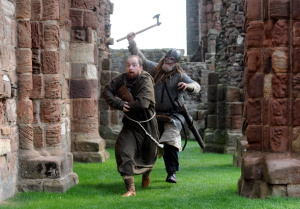Three Lessons to Learn from the Vikings
It is easy to dismiss the history of the Dark Ages as irrelevant to the development of modern society. Yet, looking back to the days of pillaging and conquest, there are a few simple lessons which we can apply today.
Lesson 1: Terror is Effective.
In the era of “war on terror”, enemies have become difficult to distinguish from ordinary people. Because of this, it appears the world has elected to militarize more than ever and impose massive intelligence operations on the denizens of nations. This is not necessarily different from the beginning of the Viking Age in the Frankish Empire. The Norse raiders attacked speedily and departed from the crime scene before any formal defense forces could be mustered. Take for example the attack on Nantes in 843 A.D. in which the Vikings entered the city in disguise during a religious festival. They sneakily unleashed a violent and bloody fury upon the city. In a chronicle mentioning the event, the people of Nantes were especially shocked that they were unable to identify the evil attackers, nor able to tell them apart from the regular tradesmen who frequented the city. The ambiguity behind the threat of the Vikings created a sense of terror. It might even be said that the first Viking raids were in fact acts of terrorism. As a result of the constant raids and inability of the Frankish leadership to retaliate, the Viking Age ushered in a new era of violence and discord. A massive shift towards militarization specifically to defend against the Vikings heralded the new epoch of violence we today associate with the Dark Ages. After all, with more soldiers, one can wage more wars. The Frankish Empire collapsed and fell into civil war. This perhaps should serve as a lesson: the wisest response to terror may not be to militarize, for it will undoubtedly plunge us into a series of unintended conflicts.
Lesson 2: People Use Religions to Justify Ridiculous Things.
One need look no further than Charlemagne’s massacre of his Saxon prisoners on the Elbe river to see that religion was used to justify ridiculous things. The Saxons were forcibly baptized, then drowned in the name of Christ. Blatant murder was justified as doing God’s work. But of course the story does not end there. No, it continues at Lindisfarne some half a decade later when the Vikings first attacked the English coast. In Scandinavian warrior culture, it is not acceptable to slaughter the unarmed unless merited by either a blood feud or a legitimate cause such as plague or famine. Yet, the Vikings at Lindisfarne massacre everyone in sight. Some of the priests were even dragged to the shore where they were forcibly drowned in the waters. And therein lies the evidence: Lindisfarne — according to a growing number of academics — was a retaliation in the name of religion. Many more priests would find this out the hard way throughout the Viking Age. This tug of war between religions at the beginning of the establishment of Christendom is an incredible insight into the folly of religious sentiment and fervor insofar as it was during this time used to justify horrendous acts of violence. But wait, that sounds indelibly familiar…
Lesson 3: Exporting Money Collapses Economies.
Danegeld was a tribute of gold and silver given to the Vikings in return for not attacking you. This worked well, except for the fact that the Vikings continued to return and ask for more money. The Danegeld tributes became so large in fact that it collapsed the primitive economies of the kingdoms of Charles the Bald and his brother Louis the German. It turns out that sending all of your money abroad tends to have a negative impact on your economy. How does that relate to today? Well, the super rich (i.e. the 0.01%) don’t like to keep their money in one place, especially away from places that might want to tax them. Thus, a significant portion of money is leaving the economies of western economies favoring the emerging economies of the east and south. What will be the result? Let’s just say that people were very, very hungry in 9th and 10th century Europe.
There are many more lessons to be learned from the Viking Age, and they are easy to find. It is as simple as opening up a book and learning. Oh yes, the Vikings liked to learn too.
Don’t forget that The Line of His People is on sale on kindle this week for $0.99! Buy your copy today to experience the next great Viking adventure novel to pillage the literary world!






